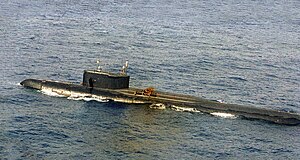
Back K-219 Azerbaijani Подводница К-219 Bulgarian K-219 German K-219 Spanish زیردریایی کی-۲۱۹ Persian K-219 French K-219 HE K-219 Italian K-219 (原子力潜水艦) Japanese K-219 Polish
 US Navy photo of K-219 on the surface after suffering a fire in a missile tube
| |
| History | |
|---|---|
| Name | K-219 |
| Laid down | 28 May 1970 |
| Launched | 8 October 1971 |
| Commissioned | 31 December 1971 |
| Stricken | 1986 |
| Homeport | Gadzhiyevo |
| Fate | Sunk by explosion and fire caused by seawater leak in missile tube, 3 October 1986 |
| General characteristics | |
| Class and type | Yankee-class submarine |
| Displacement |
|
| Length | 129.8 m (425 ft 10 in) |
| Beam | 11.7 m (38 ft 5 in) |
| Draft | 8.7 m (28 ft 7 in) |
| Propulsion | 2 × 90 MWt OK-700 reactors with VM-4 cores producing 20,000 hp (15 MW) each |
| Speed | 26 knots (48 km/h; 30 mph) |
| Test depth | 400 m (1,300 ft) |
| Complement | 120 officers and men |
| Armament |
|
K-219 was a Project 667A Navaga-class ballistic missile submarine (NATO reporting name Yankee I) of the Soviet Navy. It carried 16 R-27U liquid-fuel missiles powered by UDMH with nitrogen tetroxide (NTO). K-219 was involved in what has become one of the most controversial submarine incidents during the Cold War on Friday 3 October 1986. The 15-year-old vessel, which was on an otherwise routine Cold War nuclear deterrence patrol in the North Atlantic 1,090 kilometres (680 mi) northeast of Bermuda, suffered an explosion and fire in a missile tube. While underway a submerged seal in a missile hatch cover failed, allowing high-pressure seawater to enter the missile tube and owing to the pressure differential ruptured the missile fuel tanks, allowing the missile's liquid fuel to mix and ultimately combust. Though there was no official announcement, the Soviet Union claimed the leak was caused by a collision with the submarine USS Augusta.[1] Although Augusta was operating within the area, both the United States Navy and the commander of K-219, Captain Second Rank Igor Britanov, deny that a collision took place.[2]
The incident was novelized in the book Hostile Waters, which reconstructed the incident from descriptions by the survivors, ships' logs, the official investigations, and participants both ashore and afloat from the Soviet and the American sides.[3]
- ^ Irza, John (Fall 2004). "Soundings". IEEE Oceanic Engineering Society. Archived from the original on 16 December 2004. Retrieved 29 November 2004.
- ^ Kurdin & Grasdock 2005.
- ^ Huchthausen, Kurdin & White 1997, p. xi.